Wikipedia:Picture of the day/June 2009
|
Featured picture tools: |
These featured pictures, as scheduled below, appeared as the picture of the day (POTD) on the English Wikipedia's Main Page in June 2009. Individual sections for each day on this page can be linked to with the day number as the anchor name (e.g. [[Wikipedia:Picture of the day/June 2009#1]] for June 1).
You can add an automatically updating POTD template to your user page using {{Pic of the day}} (version with blurb) or {{POTD}} (version without blurb). For instructions on how to make custom POTD layouts, see Wikipedia:Picture of the day.Purge server cache
June 1

|
Saloon, bank, bath house and livery stable fronts on Mane Street [sic] in Pioneertown, California, an unincorporated and inhabited town built in 1946 as a TV and film set by, among others, Roy Rogers. The town was designed to provide a place for the actors to live while simultaneously having their homes used as part of the set. Photo credit: Matthew Field
Recently featured:
|
June 2

|
American singer-songwriter and folk musician Woody Guthrie, with the slogan "This Machine Kills Fascists" on his guitar. His best known song is probably "This Land Is Your Land", which is regularly sung in American schools. Many of his recorded songs are archived in the Library of Congress, and his musical legacy encompasses hundreds of political, traditional and children's songs, ballads and improvised works. Photo credit: New York World-Telegram and Sun
Recently featured:
|
June 3

|
The 26-metre (85 ft) radio telescope at Mount Pleasant Radio Observatory, located 20 kilometres (12 mi) east of Hobart, Tasmania, is the southernmost antenna used in Australia's Very Long Baseline Interferometry network. The facility is owned and operated by the University of Tasmania. Photo credit: Noodle snacks
Recently featured:
|
June 4
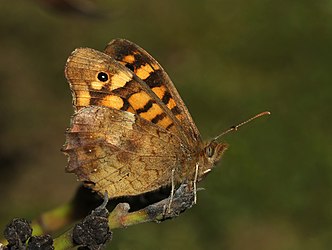
|
The Speckled Wood (Pararge aegeria ssp. aegeria shown here) is a small butterfly (4-to-4.5 cm (1.6-to-1.8 in) wingspan) found in and on the borders of woodland throughout much of Europe. Photo credit: Joaquim Alves Gaspar
Recently featured:
|
June 5

|
A woodcut print of the Quaternion Eagle, the double-headed eagle armorial of the Holy Roman Empire. It showed the shields of the various parts of the empire in groups of four on the feathers of the eagle supporting, in place of a shield, Christ on the True Cross. The top, larger shields, are those of the seven Prince-electors, as well as one for the titular "Prefect of Rome". Woodcut: Hans Burgkmair; print: David de Negker
Recently featured:
|
June 6
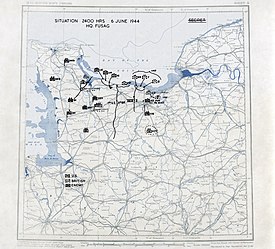
|
United States Army situation map for 2400 hours, 6 June 1944, the first day of the Normandy Landings, popularly known as "D-Day". The assault was conducted in two phases: an air assault landing of American, British and Canadian airborne troops shortly after midnight, and an amphibious landing of Allied infantry and armoured divisions on the coast of France commencing at 06:30 British Double Summer Time Map credit: Twelfth United States Army Group
Recently featured:
|
June 7
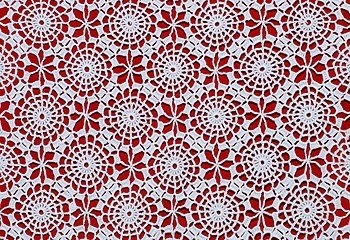
|
Detail of a Portuguese crochet tablecloth, from about 1970. Crocheting, similar to knitting, consists of pulling loops of yarn through other loops. Crochet differs from knitting in that only one loop is active at one time (the sole exception being Tunisian crochet), and that a crochet hook is used instead of knitting needles. Photo credit: Joaquim Alves Gaspar
Recently featured:
|
June 8

|
|
The City of London skyline as viewed toward the northwest from the top floor viewing platform of London City Hall on the southern side of the River Thames. Not to be confused with the London metropolitan area, the City covers 1.12 sq mi (2.90 km2) and, along with Westminster is the historic core of London around which the modern conurbation grew. Photo credit: David Iliff
Recently featured:
|
June 9
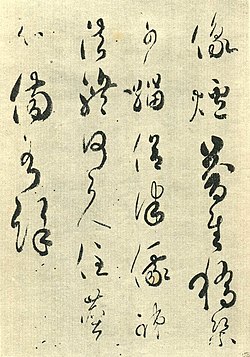
|
Cry for noble Saichō, a poem written by Emperor Saga of Japan in the 9th century, upon the death of the Buddhist monk Saichō—an early example of Japanese calligraphy. Although calligraphy as an art form had existed prior to that time, Japanese practitioners tended to imitate the styles developed by Chinese calligraphists. The influence of Chinese styles had weakened after the Heian period, with this text as one of the few surviving examples of the transformation to a native Japanese style. Image credit: Emperor Saga
Recently featured:
|
June 10
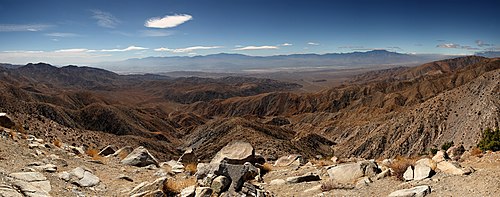
|
|
Panorama of the view southwest into Coachella Valley (California, United States) from Keys View in the Little San Bernardino Mountains within Joshua Tree National Park. Visible landmarks are the Salton Sea at rear left, along towards the center the Santa Rosa Mountains behind Indio and the San Jacinto Mountains behind Palm Springs. In the valley floor, the San Andreas Fault is clearly visible. At the rear right is the 11,500 ft (3,500 m) San Gorgonio Mountain, in the San Bernardino Mountains. Photo credit: Matthew Field
Recently featured:
|
June 11

|
Attempting to block racial integration at the University of Alabama, Governor George Wallace (left) stands defiantly at the door on June 11, 1963, in an incident known as the Stand in the Schoolhouse Door. Wallace moved aside after being ordered to do so by President John F. Kennedy; years later, he became a born-again Christian and recanted his segregationist views. Photo credit: U.S. News & World Report
Recently featured:
|
June 12

|
The Tasmanian Native-hen (Gallinula mortierii) is a flightless rail between 43 to 51 cm (17 to 20 in) in length, one of twelve species of birds endemic to the Australian island of Tasmania. Although flightless, it is capable of running quickly and has been recorded running at speeds up to 30 miles per hour (48 km/h). Photo credit: Noodle snacks
Recently featured:
|
June 13
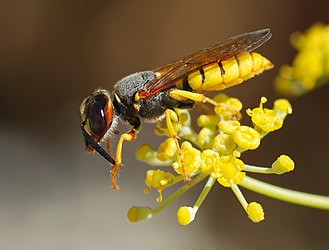
|
The European beewolf (Philanthus triangulum) is a solitary wasp that lives in Europe and Northern Africa. Though adults feed on nectar and pollen, inseminated females hunt European honey bees, using the bees as food for their larvae. Photo credit: Joaquim Alves Gaspar
Recently featured:
|
June 14
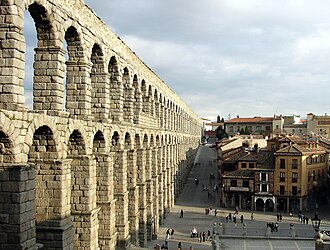
|
The Aqueduct of Segovia in Segovia, Spain, is one of the most significant and best-preserved monuments left by the Romans on the Iberian Peninsula. It was likely constructed at the end of the 1st century AD, and transported water for centuries from the Fuente Fría River over a distance of roughly 32 kilometres (20 mi) before reaching the city, only having been decommissioned recently. Photo credit: Manuel González Olaechea y Franco
Recently featured:
|
June 15

|
Former Iraqi President Saddam Hussein, in a hearing before the Iraqi Special Tribunal on July 1, 2004. This occurred over two years prior to his official trial, the result of which was that he was found guilty of war crimes, crimes against humanity, and genocide. However, during this hearing, Saddam refused to recognize the legitimacy of the tribunal and rejected all charges against him. Photo credit: United States Department of Defense
Recently featured:
|
June 16

|
|
A panoramic view of the Seven Rila Lakes, situated in the northwestern Rila Mountains in Bulgaria at an elevation of 2,100 to 2,500 metres (6,900 to 8,200 ft). Starting from the lowest lake in the rear to the highest on the left, they are (in English): the Lower Lake, the Fish Lake, the Trefoil, the Twin, the Kidney, and the Eye. The seventh lake, the Tear, is not visible here. Photo credit: Anthony Ganev
Recently featured:
|
June 17

|
U.S. President Gerald Ford appearing at an October 1974 House Judiciary Subcommittee hearing regarding his pardon of Richard Nixon. Nixon had resigned due to his involvement in the Watergate scandal, which began with an attempted break-in at the Democratic National Committee headquarters at the Watergate Office complex on June 17, 1972. Photo credit: U.S. News & World Report
Recently featured:
|
June 18

|
In the history of cartography, this chart of Pedro Reinel (c. 1504) is one of the oldest known nautical charts with a scale of latitudes and constructed on the basis of astronomical observations. This new cartographic model was developed by the Portuguese in the second half of the 15th century and it is known as the "plane chart" or "latitude chart".
Recently featured:
|
June 19

|
An arborist working about 25 metres (82 ft) above the ground using a chainsaw to fell a eucalyptus tree in a public park. Arborists practice arboriculture, which is the management and maintenance of ornamental or shade trees. An arborist is distinct from a forester, or from a logger. Photo credit: John O'Neill
Recently featured:
|
June 20
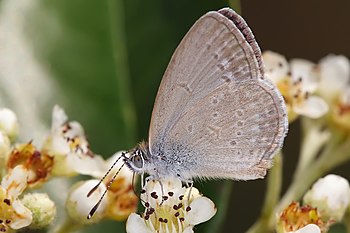
|
The Common Grass Blue (Zizina labradus) is a small butterfly found throughout Australia and neighbouring islands. Adults are purplish blue on the upper wing surface with a black body and black or brown wing margins. Photo credit: Fir0002
Recently featured:
|
June 21
|
Armadillo Aerospace's "Pixel" in test flights before the inaugural Lunar Lander Challenge in 2006. The goal of the competition is to launch a VTVL rocket capable of moving between the surface of the Moon and its orbit. Although Armadillo made the first successful flight of a private vehicle of this class, no entrant has been able to successfully complete the mission yet. Photo credit: Armadillo Aerospace
Recently featured:
|
June 22
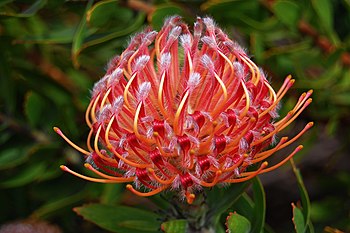
|
A Leucospermum 'Scarlet Ribbon' cultivar. This genus of about 50 species of flowering plants is native to Zimbabwe and South Africa, where they occupy a variety of habitats, including scrub, forest, and mountain slopes. Photo credit: Flying Freddy
Recently featured:
|
June 23
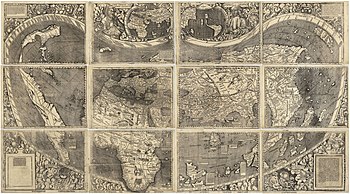
|
The Waldseemüller map is a map drawn by German cartographer Martin Waldseemüller originally published in April 1507. It was one of the first maps to chart latitude and longitude precisely, the first map to use the name "America", and the first to depict the Americas as separate from Asia. Credit: Martin Waldseemüller
Recently featured:
|
June 24

|
The Embden Goose is a breed of domestic goose, named for the town of Emden in Lower Saxony, Germany, from where it was once thought they originated. Embdens are pure white with a light orange, short, bill, and orange feet and legs. They are fast-growing birds and females will reach about 9 kg (20 lb), with males growing up to 14 kg (31 lb). Photo credit: Noodle snacks
Recently featured:
|
June 25

|
A schematic of the V-2 rocket, the first ballistic missile, the first man-made object to achieve sub-orbital spaceflight, and the progenitor of all modern rockets. Developed by Wernher von Braun on behalf of Nazi Germany, and based on work by Robert H. Goddard, over 3,000 V-2s were launched during World War II against Allied targets, resulting in the death of an estimated 7,250 military personnel and civilians. An estimated 20,000 inmates at Mittelbau-Dora died constructing V-2s, making the V-2 perhaps the only weapon system to have more deaths caused by its production than its deployment. Image credit: Fastfission
Recently featured:
|
June 26

|
"Au Clair de la Lune", a traditional French folk song, from a 1910s children's book. It is commonly taught to beginner students of various instruments. Listen to: An 1860 recording of the song, which is believed to be the oldest recognizable sound recording of a human voice in existence. Image: Louis-Maurice Boutet de Monvel
Recently featured:
|
June 27
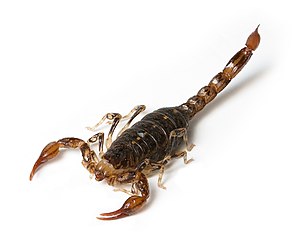
|
The Forest scorpion (Cercophonius squama) is a scorpion native to southeastern Australia and Tasmania. The body is 25 to 40 millimetres (0.98 to 1.57 in) long, and coloured creamy yellow to orange brown with dark brown variegations. The legs are yellow with some dark brown pigment. Photo credit: Noodle snacks
Recently featured:
|
June 28
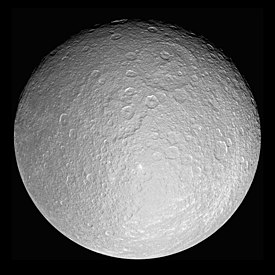
|
Rhea, at 1,528 kilometres (949 mi) across, is the second-largest moon of Saturn and the ninth largest moon in the Solar System. It was discovered in 1672 by Giovanni Domenico Cassini, who named it after the Titan Rhea of Greek mythology, "mother of the gods". The giant Tirawa impact basin is seen above and to the right of center. Tirawa, and another basin to its southwest, are both covered in impact craters, indicating they are quite ancient. Photo credit: Cassini orbiter
Recently featured:
|
June 29
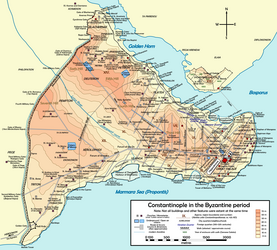
|
A map of Constantinople, the capital of the Byzantine Empire. Throughout the Middle Ages, Constantinople, strategically located between the Golden Horn and the Sea of Marmara at the point where Europe meets Asia, was Europe's largest and wealthiest city. It was officially renamed to its modern name Istanbul (Turkish: İstanbul) in 1930. Map credit: Konstantinos Plakidas
Recently featured:
|
June 30
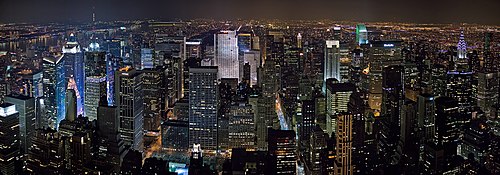
|
|
A view of the Midtown Manhattan skyline, as seen from the Empire State Building. This area of New York City contains many of the city's most iconic buildings, such as the Condé Nast Building (far left), the GE Building (left of center), the Citigroup Center (right of center), the MetLife Building and the Chrysler Building (both visible on the right). Photo credit: David Iliff
Recently featured:
|
Picture of the day archives and future dates
